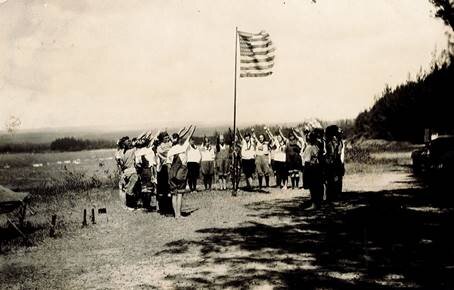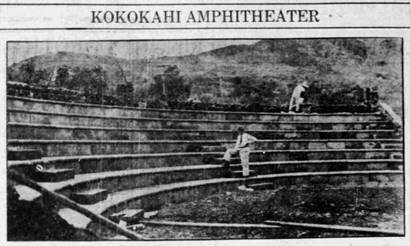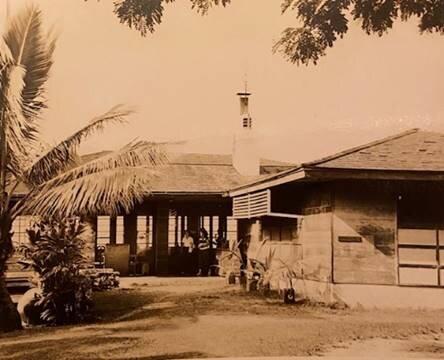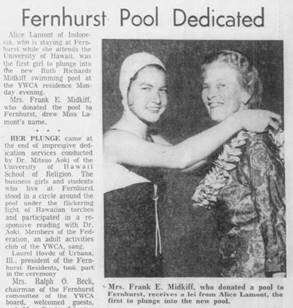A Moment in Our History: Kokokahi – A Place Where All Gather in the Shared Spirit of "One Blood"
For the first 25 years after its founding in 1900, YWCA O'ahu created and offered a number of classes at its main office and across town. The organization also made efforts to organize a camp program.
In 1920, the YWCA conducted the Halekipa (House of Welcome) program for a month in the summer to give camping experiences to students from grade schools, high schools and so-called “normal schools” (what later came to be known as “teacher colleges”—training for high school graduates). This provided opportunities for “getting together in the out-of-doors away from school rooms and Y.W.C.A. buldings.”
In 1920, YWCA O'ahu started the Halekipa program
The aim of Halekipa was “to develop all around girls, physically, mentally, socially and spiritually.” The participants were divided into groups and each group strived for honor points in “knowledge, health and spirit.”
Camp Staff and Counselors made sure all the participants were fully engaged in daily activities
Examples of earning knowledge honors would include learning the names of flowers and trees or writing poems and contributing to the camp paper called the Halekipa Wave. Health honors required participants to win in sports activities such as volleyball, baseball, running and swimming or to demonstrate life saving tests. Spirit points went to those who demonstrated good sportsmanship, and general helpfulness.
Halekipa participants engaged in various activities based on the camp’s three themes: knoweldge, health and spirit
The first-year program was hosted on the school grounds of the Kahuku plantation with tents loaned by the army. A committee of women felt that the “camp should be located nearer the beach” and moved the program to Waialua plantation, which offered a stretch of land along the shore at Puuiki.
The camp curriculum was filled with activities throughout the day including a daily flag ceremony before breakfast
In the early 1930’s Halekipa found a new site – Kokokahi on Windward O'ahu.
Kokokahi opened in 1927 in a valley of “41 verdant acres on Windward O'ahu with an 800-foot frontage on Kaneohe Bay.” It was based on the idea of creating “a combined conference, camp and vacation home area, shared by Christian of all races” – an idea put forth by Dr. Theodore Richards, originally from Montclair, NJ.
Dr. Theodore Richards moved to Hawaii in 1889 at the age of 22. He was appointed the principal of the Kamehameha schools four years later
The responses to Dr. Richards’ idea were not all favorable. Some people even called his plan “absurd” or “freakish.” Yet, this former principal of Kamehameha Schools moved forward with persistence to actualize his dream of creating a multi-racial community on land he purchased from Kaneohe Ranch– calling it Kokokahi, or “Of One Blood.”
When Dr. Richards presented his idea of Kokokahi, some did not show a favorable response. (Honolulu Star-Bulletin: June 8, 1927)
In 1931, Kokokahi added an amphitheater. Various missionary families contributed to Kokokahi for the creation of Kauhale or missionary cottages during the depths of the depression. Among the names placed over the cottage doors were Alakanadero (Alexander), Balawina (Baldwin), Kuke (Cooke), Kakela (Castle), Koana (Coan), Hikokoke (Hitchcock), Kamika-Lowela (Smith-Lowell), Laiana (Lyons) Wilikoki (Wilcox) and Likeke (Richards).
Honolulu Star-Bulletin: August 21, 1931
The cabins Hawaii’s missionary families helped create still stand on the grounds of Kokokahi today.
In 1935, YWCA O'ahu established Camp Halekipa on 10 acres of waterfront property with funds largely provided by the Juliette M. Atherton Trust. The construction of Atherton Hall was completed one year later. The Halekipa site was directly across the road from Kokokahi Camp. The two organizations cooperated as “a reciprocal relationship in the use of the facilities existed between the two camps.”
Juliette M. Atherton Hall
Atherton Hall today
Mrs. Juliette M. Atherton
Halekipa at Kokokahi offered programs not only for young people but also for “tired-out-business-men and housewives who went there to be rejuvenated and learn how to make their life programs more worthwhile.”
Adults also gathered at Kokokahi for a get-away
The first mothers’ camp was reportedly held in 1929. It became an instant hit and was turned into an annual event.
“While on their outing, the mothers are relieved of all cooking and meal planning and have their entire time free to devote to demonstrations and recreations. Like all campers, the mothers have not been anxious to go home when their three days’ camp is over.”
-Honolulu Star-Bulletin: March 26, 1938
Mothers enjoyed a weekend retreat at Kokokahi. Many wished to stay longer.
In 1955 Halekipa and Kokokahi merged, which allowed YWCA O'ahu to manage the operations of the combined sites. The merger was guided by Mrs. Frank E. (Ruth Richards) Midkiff, Dr. Richards’ daughter and the YWCA board president between 1936 and 1939. The combined operation was called the Kokokahi YWCA “perpetuating the name and purpose which were the dream of Dr. Richards.”
Mrs. Frank E. (Ruth Richards) Midkiff – pictured at left in a black dress – played a pivotal role for the merger of Kokokahi and Halekipa. Kokokahi was created by her father Dr. Theodore Richards. The trust her grandmother created, Juliette M. Atherton Trust, made possible the establishment of Halekipa in 1935.
In 1959, Mrs. Midkiff donated a pool to Fernhurst (which no longer exists)
The Honolulu Advertiser: June 10, 1959
The Honolulu Advertiser: June 12, 1955
In 1974, the trustees of the Kokokahi Community Trust dissolved the trust and its assets were given to YWCA O'ahu to administer in its own name. More than 90 years later, Kokokahi continues to embrace the philosophy of Dr. Richards – it is a place where all gather in the shared spirit “Of One Blood.”
Dr. Theodore Richards with his wife Mrs. Mary Atherton Richards. The trust her mother created, the Juliette M. Atherton Trust, supported many YWCA projects including the construction of the original Fernhurst designed by Julia Morgan and Atherton Hall at Kokokahi. The couple’s philanthropic work touched many who pursued further education. (Picture from The Honolulu Advertiser: November 25, 1945)
In 1957, a pool was added to Kokokahi. Volunteers went door-to-door to collect donations. The idea for the pool was reportedly sparked by tragedy in 1954, when two Windward O'ahu youngsters drowned in Kaneohe Bay. (The Honolulu Advertiser: November 25, 1956)
Ruth Richards Midkiff Hall (today known as Midkiff Gym) opened in 1970. Mr. Robert Richards Midkiff (Dr. Richards’ grandson) spoke at the opening of the gym which was named after his mother. The gym roof was replaced in 2016 after a capital campaign which raised $824,000.
-Noriko Namiki, YWCA O‘ahu CEO






























